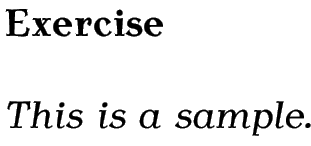10. Defining Environments
Just as you can define new commands, you can also define new environments. The command
is used to define a new environment. As with new commands, you can use the optional argument <n-args> to define an environment with arguments, and <default> to define an environment with an optional argument.
The first argument <env-name> is the name of your new environment. Remember that the environment name must not have a backslash. The mandatory arguments <begin-code> and <end-code> indicate what LaTeX should do at the beginning and end of the environment. Note that although <begin-code> can reference the arguments using #1 etc, the <end-code> part can't.
Example (An Exercise Environment):
Let's first consider an example of an environment without any arguments. Let's make an environment called, say, exercise that prints Exercise in bold and typesets the contents of the environment in italic, with a gap between the title and the contents. In other words, we want the following code:
to produce the following output:
(In the next chapter we will add numbering.)
Let's first consider what we want this environment to do: we can get
the word “Exercise” in bold using \textbf,
and the italic font can be
obtained by using the itshape environment (recall
§4.5. Fonts).
So, at the start of our
new environment we need
and at the end of our new environment we need to end the itshape environment:
Putting the above together into the new environment definition:
\newenvironment{exercise}% environment name
{% begin code
\textbf{Exercise}\begin{itshape}%
}%
{
\end{itshape}}% end code
Let's try it out:
\begin{exercise}
This is a sample.
\end{exercise}
Not quite right. Let's put a paragraph break after
Exercise, and put one before it as well. The command
\par can be used to make a paragraph break and the extra bit of
vertical spacing can be produced using \vspace. The
length \baselineskip is the interline spacing.
Modifications are shown in bold like this.
\newenvironment{exercise}% environment name
{% begin code
\par\vspace{\baselineskip}%
\textbf{Exercise}\begin{itshape}%
\par\vspace{\baselineskip}%
}%
{
\end{itshape}}% end code
Let's have a look at the output now:

\noindent.
It's also a good idea to suppress
any spaces immediately following \begin{exercise} and \end{exercise}, which can be done
using \ignorespaces and \ignorespacesafterend.
Modifications are again shown in bold like this.
\newenvironment{exercise}% environment name
{% begin code
\par\vspace{\baselineskip}\noindent
\textbf{Exercise}\begin{itshape}%
\par\vspace{\baselineskip}\noindent\ignorespaces
}%
{% end code
\end{itshape}\ignorespacesafterend
}
The exercise environment now appears as:

Now let's modify our code so that the environment takes an argument. The argument should indicate the exercise topic. For example, the following code:
\begin{exercise}{An Example}
This is a sample.
\end{exercise}
should produce the following result:
As with \newcommand, #1 is
used to indicate the first argument. We can now modify the code as
follows:
\newenvironment{exercise}[1]% environment name
{% begin code
\par\vspace{\baselineskip}\noindent
\textbf{Exercise (#1)}\begin{itshape}%
\par\vspace{\baselineskip}\noindent\ignorespaces
}%
{% end code
\end{itshape}\ignorespacesafterend
}
This book is also available as A4 PDF or 12.8cm x 9.6cm PDF or paperback (ISBN 978-1-909440-00-5).


